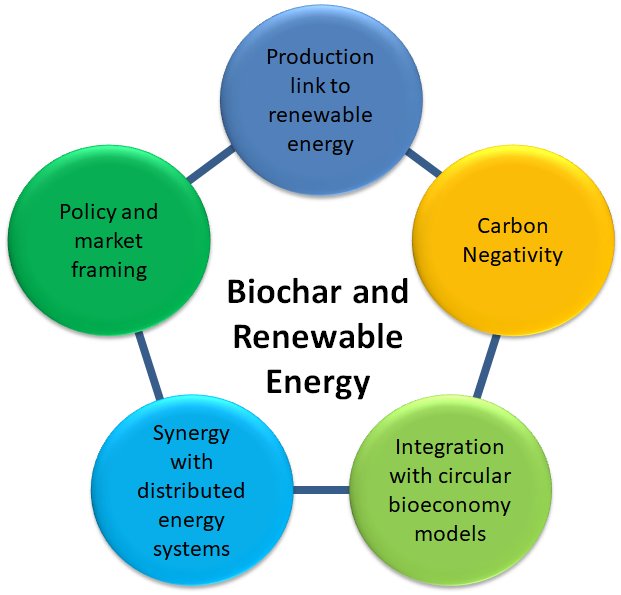 | Contextualizing Biochar as a Renewable Energy Resource
|
| Hari Srinivas | |
| One-Pager Series E-227 |
Introduction
Biochar, a carbon-rich material produced through the thermochemical conversion of biomass, offers a unique bridge between renewable energy production and environmental stewardship. Unlike other renewable energy technologies that focus solely on generating power, biochar systems can simultaneously produce usable energy, lock away carbon, and deliver tangible benefits to agriculture and ecosystems.
To fully understand its potential, biochar must be seen not in isolation but within the broader renewable energy and circular economy landscape. The following five dimensions outline how biochar fits into this framework.

Figure 1: Biochar and Renewable Energy
-
1. Production Link to Renewable Energy
- Biochar is typically produced through pyrolysis, gasification, or other thermochemical processes that heat biomass in low-oxygen environments. These processes yield syngas and/or bio-oil alongside the solid biochar.
- The syngas and bio-oil are renewable fuels that can be used for electricity, heat, or liquid fuel production, displacing fossil fuels.
- In this way, biochar is not just a byproduct - it is part of a renewable energy generation cycle, where energy is harvested and a stable carbon-rich residue is created.
2. Carbon Negativity within Renewable Energy Systems
Unlike most renewable energy sources, biochar can go beyond carbon neutrality and achieve net carbon removal.
- Most renewable energy sources (solar, wind, hydropower) are carbon-neutral at best. Biochar has the rare potential to be carbon-negative.
- When biomass grows, it captures atmospheric CO?. Converting it to biochar locks carbon into a stable form that can persist in soils for centuries, while the energy co-products provide low-carbon energy.
- This dual benefit positions biochar as a unique renewable energy technology with long-term climate mitigation potential.
3. Integration into Circular Bioeconomy Models
Biochar supports a circular use of resources, turning biomass residues into both clean energy and valuable agricultural amendments.
- In agricultural residues management, producing biochar from crop waste turns what is often burned or landfilled into both renewable energy and a soil enhancer.
- In forestry and land management, using woody residues for biochar production can generate rural renewable energy while improving soil health and reducing wildfire fuel loads.
- This fits into waste-to-energy and circular economy approaches that aim for maximum value extraction from biomass.
4. Synergy with Distributed Renewable Energy Systems
Biochar production systems can be adapted to decentralized, small-scale operations that meet both local energy and agricultural needs.
- Small- and medium-scale pyrolysis units can operate off-grid in rural or developing areas, providing local renewable electricity and heat while producing biochar for farming communities.
- This positions biochar systems as decentralized renewable energy solutions that also enhance food security and land productivity.
5. Policy and Market Framing
Biochar can be positioned in energy policy as both a renewable energy source and a climate change mitigation tool.
- In the renewable energy policy sphere, biochar can be recognized not just under biomass energy categories, but also in carbon credits, soil carbon sequestration programs, and renewable heat incentives.
- This opens pathways for stacked revenue streams: energy sales, carbon credits, and agricultural benefits.
Conclusion
Positioning biochar as a renewable resource reframes it from a niche soil amendment to a multi-benefit climate and energy solution. Its ability to generate renewable energy, sequester carbon, and support agricultural productivity makes it an important component of a future low-carbon economy. By integrating biochar into renewable energy policy, market incentives, and distributed energy systems, we can unlock its full potential to deliver both environmental and socio-economic gains.

Member of
Japan Biochar Association
This work by GDRC is licensed under a Creative Commons Attribution-ShareAlike 4.0 International License. You are free to share and adapt this piece of work for your own purposes, as long as it is appropriately citied. More info: http://creativecommons.org/licenses/by-sa/4.0/
on
Return to Urban Energy
Contact:
Biochar production is inherently tied to renewable energy generation, as it is created through processes that also yield usable renewable fuels.